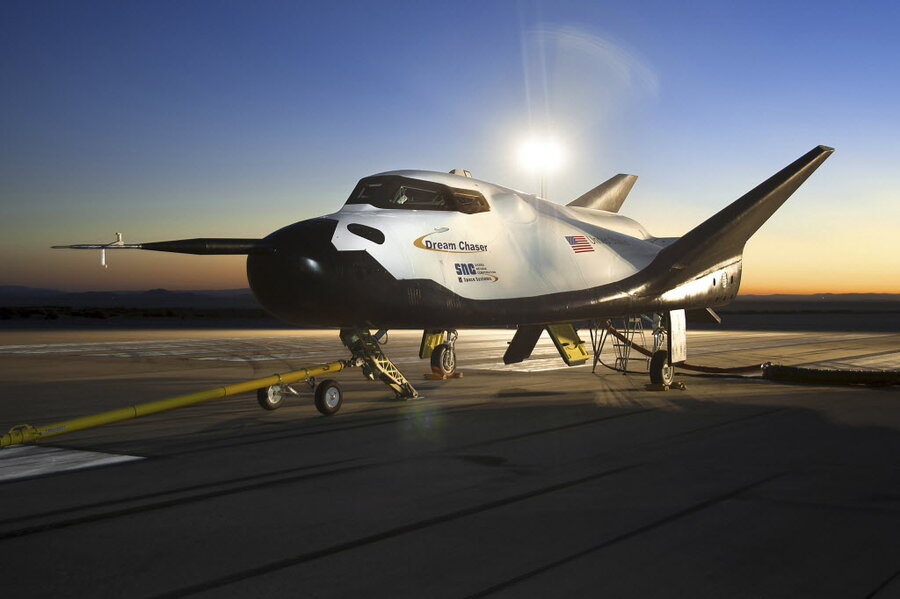Dream Chaser spacecraft test flight goes perfectly, except for one thing
Loading...
Sierra Nevada Corp.'s prototype for its Dream Chaser spacecraft made a less-than-100-percent successful test flight over the weekend, in a possible misstep in the developer’s attempts to secure a NASA contract to transport astronauts between Earth and the International Space Station.
Dream Chaser flew freely for the first time on Saturday when it was released from a helicopter at an altitude of some 12,500 feet. The neat glide to Earth followed up on two previous attached test flights for the space plane. But during the landing, what had been up until then an error-free descent skidded into trouble at Edwards Air Force Base, near Lancaster, Calif. Upon touchdown, a landing gear malfunction sent the plane off the tarmac.
Mark Sirangelo, space systems chief for Sierra Nevada, told Space.com that the damage to Dream Chaser was light and repairable. Astronauts in the craft would have been unscathed, he said (this test flight was unmanned).
He stressed to Space.com that the landing error was minor relative to the success of the free flight, which has been compared in the press to the debut test flight of the Space Shuttle Enterprise some 36 years ago. That prototype showed in three test flights, in which it was dropped from a Boeing 747 over California, that a shuttle could glide to a safe landing, a feared sticking point in the development of the shuttle program.
“While there was an anomaly with the left landing gear deployment, the high-quality flight and telemetry data throughout all phases of the approach-and-landing test will allow SNC teams to continue to refine their spacecraft design,” said Sierra Nevada, in a statement. “As with any space flight test program, there will be anomalies that we can learn from.”
Sierra Nevada’s public video of the test flight ends before the botched landing, The Washington Post reported.
Sierra Nevada’s insistence that its prototype is doing just fine is expected, as the private company is in the midst of competing with two others for a plum contract with NASA to ferry astronauts to the ISS. For the developer to continue receiving funds from NASA to build Dream Chaser, and to remain in the running for the agency's contract, it must demonstrate at regular intervals that its design is meeting expected milestones, NASASpaceFlight.com reported.
NASA, since dismantling its space shuttle program in 2011, has been sending its astronauts to the ISS aboard Russia’s Soyuz capsules – for a fee as jarring as a rocket booster, or about $70 million per seat. NASA’s $424 million contract with Russia is valid until 2019 but NASA has said it hopes to have its own spacecraft as early as 2017, depending on funding support from Congress.
NASA has supplied three companies, Sierra Nevada, SpaceX, and Boeing, with millions of dollars to develop proposed designs for a new spacecraft that will end the agency’s pricey reliance on Russia. Both SpaceX and Boeing have proposed capsule designs for the spacecraft: SpaceX is working on the Dragon Capsule, while Boeing is developing the CST-100. But Sierra Nevada is designing to a different tune: it is building what looks like a miniature space shuttle.
Dream Chaser is modeled on a NASA concept vehicle, HL-20, an imagined but never built “space taxi” designed in the 1980s. That’s a choice of design that has at times exposed Sierra Nevada to the subtle derision that it is building a spacecraft based on a design now more than two decades old. HL-20 is also a close derivative of the HL-10 design, from the 1960s, Space.com reported.
Sierra Nevada has noted, though, that the craft is more advanced than the design floated back in the 1980s: the space plane’s propulsion systems are modeled off of those used in Scaled Composites would-be commercial spaceship, SpaceShipTwo. The developer also emphasizes that HL-20 “has years of development, analysis, and wind tunnel testing.”
The three-way tug of war for NASA’s contract is concurrent with a separate tussle – similar in the amount of dollars spent and the altitudes reached for – for control over the still hypothetical space tourism market. Last week, a new commercial space outlet, World View, announced plans to sell $75,000 trips to the middle of the stratosphere aboard a capsule tethered to a giant balloon. The venture plans to set up shop at the same launch point, New Mexico’s Spaceport America, as does Virgin Galactic, the commercial outlet that plans to sell blastoffs into space at $250,000 a seat.








